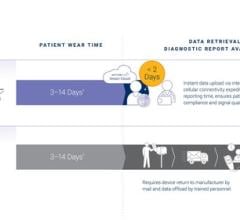
Preventice Three-in-one Switchability BodyGuardian Remote Monitoring System
October 10, 2014 — Preventice Inc. announced improvements to its BodyGuardian Remote Monitoring System that have the potential to simplify the remote monitoring experience for patients and contribute to a more efficient care delivery process when transitioning between monitoring needs for individual patients. At the same time, the improved BodyGuardian could simplify administrative billing and service operations for health care providers. The BodyGuardian product enhancements make these improvements possible by combining three essential monitoring technologies — mobile cardiac telemetry, event monitoring and Holter monitoring — in one easy-to-use device.
“For years, monitoring patients at varying stages of cardiac disease has necessitated the use of multiple monitoring devices, which can create confusion and anxiety for the patient—not to mention a prolonged monitoring experience, additional training for clinicians and patients, and billing complexity,” said Bryan Claseman, vice president of marketing for Preventice. “The BodyGuardian addresses these issues by combining the three most common types of monitoring technologies into one device.”
Cardiac patients are typically monitored in one of three ways, and oftentimes, healthcare providers will need to switch between the following monitoring devices to get a clear and correct diagnosis: 1) mobile cardiac telemetry, which collects a broader base of physiological data in near real time over a longer time period; 2) event monitoring, wherein rhythms are tracked in conjunction with a specific cardiac event such as bradycardia, and 3) Holter monitoring, which tracks cardiac rhythms in near real time for short periods. The BodyGuardian now enables clinicians to switch between these monitoring modes to diagnose varying patient needs, with one easy-to-use device.
“Diagnosing a cardiac condition can take time and may require multiple diagnostic approaches,” said Peter Brady, medical director, Electrocardiographic, Heart Rhythm and Physiological Monitoring Laboratory, at the Mayo Clinic. “Transitioning between different monitoring modes would normally add time and complexity to this process for both patients and providers. Using a single device with three-in-one switchability has the potential to alleviate this, allowing health care facilities to deliver a more seamless and effective patient care experience.”
The BodyGuardian can potentially lead to a faster diagnosis and, ultimately, treatment than traditional devices because health care providers do not have to physically exchange devices with their monitoring facility, which can delay the delivery of reports about a patient’s condition until after the device is returned and reports are downloaded. Instead, the BodyGuardian allows the provider to move between monitoring approaches with the flip of a virtual switch.
“Delivering continuity of care and a safe, seamless patient experience is of utmost importance to health care providers today,” said Jon Otterstatter, president and founder of Preventice. “As health reform demands a greater focus on quality outcomes and reducing costs, providers will turn to technology like remote monitoring to diagnose and treat more patients in ways that use time, money and staff resources efficiently and effectively.”
Developed in collaboration with Mayo Clinic, the BodyGuardian uses sophisticated algorithms to support remote monitoring for individuals with cardiac arrhythmias. The BodyGuardian is approved for use in detecting and monitoring non-lethal cardiac arrhythmias for ambulatory patients.
For more information: www.preventice.com


 March 31, 2025
March 31, 2025 





